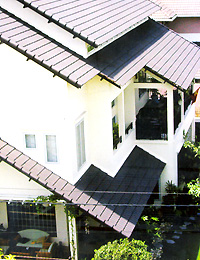Secrets of waterproofing houses (2)
Basic waterproofing story must be based on synchronous and radical coordination right from the beginning between the design, selection of materials, construction techniques, use and maintenance and maintenance works.
 Roof drainage system must be done very carefully (Photo: Nhadep) Some regular water contact spaces such as lakes (tanks) containing water, swimming pools, sanitary floors, washing machines, flower souls, roofs without roofs balcony, balcony . surely the ability to absorb will be higher than other areas in the house. It is well known from the top to the bottom, but there is also a reverse osmosis from the floor due to bad calculation of the wall footprint. Then permeate the basement wall, permeate the side due to the gap between the two houses, the seepage due to the scaffolding hole has been completely withdrawn .
Roof drainage system must be done very carefully (Photo: Nhadep) Some regular water contact spaces such as lakes (tanks) containing water, swimming pools, sanitary floors, washing machines, flower souls, roofs without roofs balcony, balcony . surely the ability to absorb will be higher than other areas in the house. It is well known from the top to the bottom, but there is also a reverse osmosis from the floor due to bad calculation of the wall footprint. Then permeate the basement wall, permeate the side due to the gap between the two houses, the seepage due to the scaffolding hole has been completely withdrawn .
Permeability is sometimes very sloppy when we see the patchy ceiling, but on the floor, there is no clue. Permeate this place, but it must be against it, or it can be found only in one place, but it must be against the whole. And more importantly, waterproofing must be calculated from the time of design, from the time of making the rough part, not waiting until the time of being absorbed to take care of it.
A double benefit
The effectiveness of the waterproofing solution - if considered from the beginning - will simultaneously bring a multi-faceted effect: leak-proof, heat-proof, noise-proof and anti-rutting. The casting of two-layer roofing floor, the inventory of knitting sheets with air gaps in the middle, roofing of slopes to " cover " flat roofs, using steel or wood floors to make the above items . all minimize the effect of direct sun rain. Next, ie cum always against heat and anti-crack roof structure. For external walls, if possible, a double-walled wall should be built, with an insulating layer in the middle of a hot-dip combination. Use standard bricks. Quality, type and origin of masonry bricks are also important to avoid rapid deterioration of walls. At joints or connections between walls and doors, it is required to have a ribbed structure or a protective edge.
For underground works, the solution " strong and durable " always proved to be more effective. Currently popular is the way to build an underground reservoir by brick card, soaked in cement and plastered plaster, then put the water tank inside, on the concrete lid with the opening and suction pump for maintenance. periodic rinse. This way of doing so is to avoid seepage rather than waterproofing. Of course, this way is costly but in return, much safer and more sanitary, does not occupy the area. In case the house is built on soft ground, the first floor should pour high quality concrete to both reverse water or permeate due to underground water, both to prevent subsidence, when the house next to the construction or the car runs outside causing shock.
Part 1
- Secrets of waterproofing houses (1)
- New waterproofing technology for electronic devices
- Nokia develops 'super waterproofing' technology
- Research fire ant behavior to develop rescue robots, waterproofing materials
- Surprise with the way people of the previous century predicted the houses of our time
- The eggs-shaped eco-houses are extremely toxic
- Research: Create perfect super-waterproof material
- The most exotic houses in the world
- Cozy: A modular home that simulates a hobbit-style low-rise house
- Ultra-Ever Dry: Nanotechnology to waterproof all types of liquids
- The detailed process of building mini houses according to the standard of building real houses
- Unique: Build houses like playing Lego
 'Barefoot engineer' invents a pipeless pump
'Barefoot engineer' invents a pipeless pump Process of handling dead pigs due to disease
Process of handling dead pigs due to disease Radiometer
Radiometer Warp Engine: Technology brings us closer to the speed of light
Warp Engine: Technology brings us closer to the speed of light